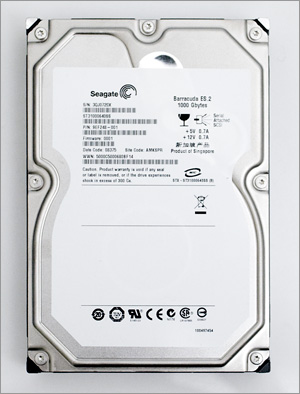Seagate Barracuda ES.2 1TB SAS Hard Drive
Details and Specifications
Upon first glance, the Barracuda ES.2 SAS looks like any standard 3.5" SATA hard drive. Visually, it’s hard to see any difference between the Barracuda ES.2 SAS and SATA models. However, upon closer inspection, one can see that the power/data connector is slightly different compared to what you would see with a standard SATA hard disk.
 ES.2 SAS 1 TB - Top |
 ES.2 SAS 1 TB - Bottom |
SAS hard drives share the same physical cables as SATA hard drives, but they use a single connector which has data and power in a single connector. It’s pretty confusing for end-users to understand, but basically what you need to know is that SAS hard drives require SAS adapters in order to run in a desktop/tower chassis environment (adapters can cost anywhere from $10 - $50). In a rackmount environment, one can typically use SAS hard drives in standard SATA disk cages.
 SAS Interface on the Barracuda ES.2 |
 Promise TX2560 SAS Controller |
For our tests, we used Promise’s new consumer-targeted TX2560 SAS controller card, which can be had for a mere $70 today (2 x SAS adapters included). Most SAS cards with hardware RAID prcessors price out in the $300+ range, so seeing affordable SAS adapters is definitely exciting to see. Not surprisingly, such a product only provides the very basics for a SAS disk setup, including support for two SAS 3GB/s or SATA-II/300 drives, a PCI Express x1 interface, and support for RAID 0, 1 and JBOD modes. The card utilizes the Promise PDC42819 controller, which is a software-based solution, meaning there is no dedicated RAID processor onboard. However, with only two ports, the need for hardware RAID processing is slim, and the increased latencies of such a solution might hurt single/dual disk performance. We’re just glad to see something finally filling up those PCI Express x1 slots which sit empty on so many of today’s motherboards.
The Barracuda ES.2 1TB SAS drives are nearly identical to their SATA-equipped Barracuda ES.2 brethren. Both the Barracuda ES.2 SATA and SAS drives support up to 1 TB of storage capacity and are housed in a standard 3.5" form factor. Both drives have 7,200 RPM spindle speeds, and both are equipped with 5 year warranties. Both the SATA and SAS variants can sustain 105 MB/s transfer rates at their peak. There are differences, however - and one is somewhat of a major one. For reasons unknown, Seagate decided to strip down the SAS variant and only offer it with 16 MB of cache, whereas the SATA variant has a larger 32 MB of cache on the high-end models. The SAS version also consumes a bit more power, although the difference is a somewhat trivial 1W.
| Western Digital Caviar RE2 750 GB | Seagate Barracuda 7200.11 SATA | Seagate Barracuda ES.2 1 TB SATA | Seagate Barracuda ES.2 1 TB SAS | |
| Spindle Speed | 7,200 RPM | 7,200 RPM | 7,200 RPM | 7,200 RPM |
| Platter Count | 3 | 4 | 4 | 4 |
| Cache Memory | 16 MB | 32 MB | 32 MB | 16 MB |
| Average Seek Time | 8.9ms | N/A | N/A | N/A |
| Average Latency | 4.20ms | 4.16ms | 4.16ms | 4.16ms |
| Interface | Serial ATA-II/300 | Serial ATA-II/300 | Serial ATA-II/300 | Serial Attached SCSI 3 GB/s |
| Acoustics | 28 dBA (Idle) 34 dBA (Seek) |
27 dBA (Idle) 29 dBA (Seek) |
27 dBA (Idle) | 27 dBA (Idle) |
| MTBF | 1.2 Million Hours | 750,000 Hours | 1.2 Million Hours | 1.2 Million Hours |
| Warranty | 5 Years | 5 Years | 5 Years | 5 Years |
The Barracuda ES.2 SAS has a few competitors – namely Seagate’s own ES.2 SATA product line which has similar features but a different connector, more cache, and will (likely) sell at a lower price point. Potential buyers will likely be interested in how the drive compares to other similarly classed high-capacity drives. However, in the land of truly high-capacity SAS storage, the Barracuda ES.2 SAS stands alone, as its closest competitor has less than 1/3rd the capacity (300 GB) and costs about three times as much as the ES.2.






